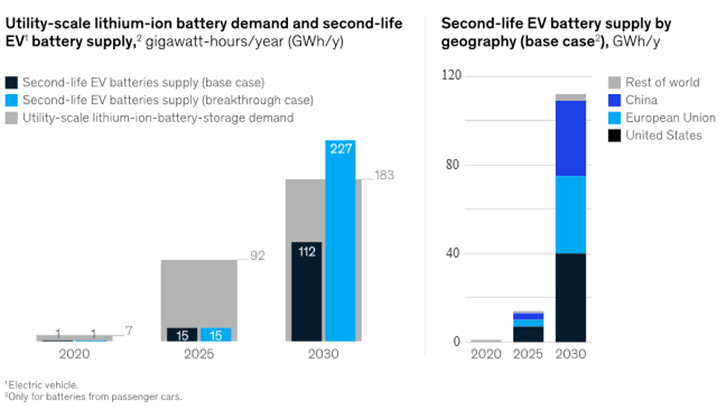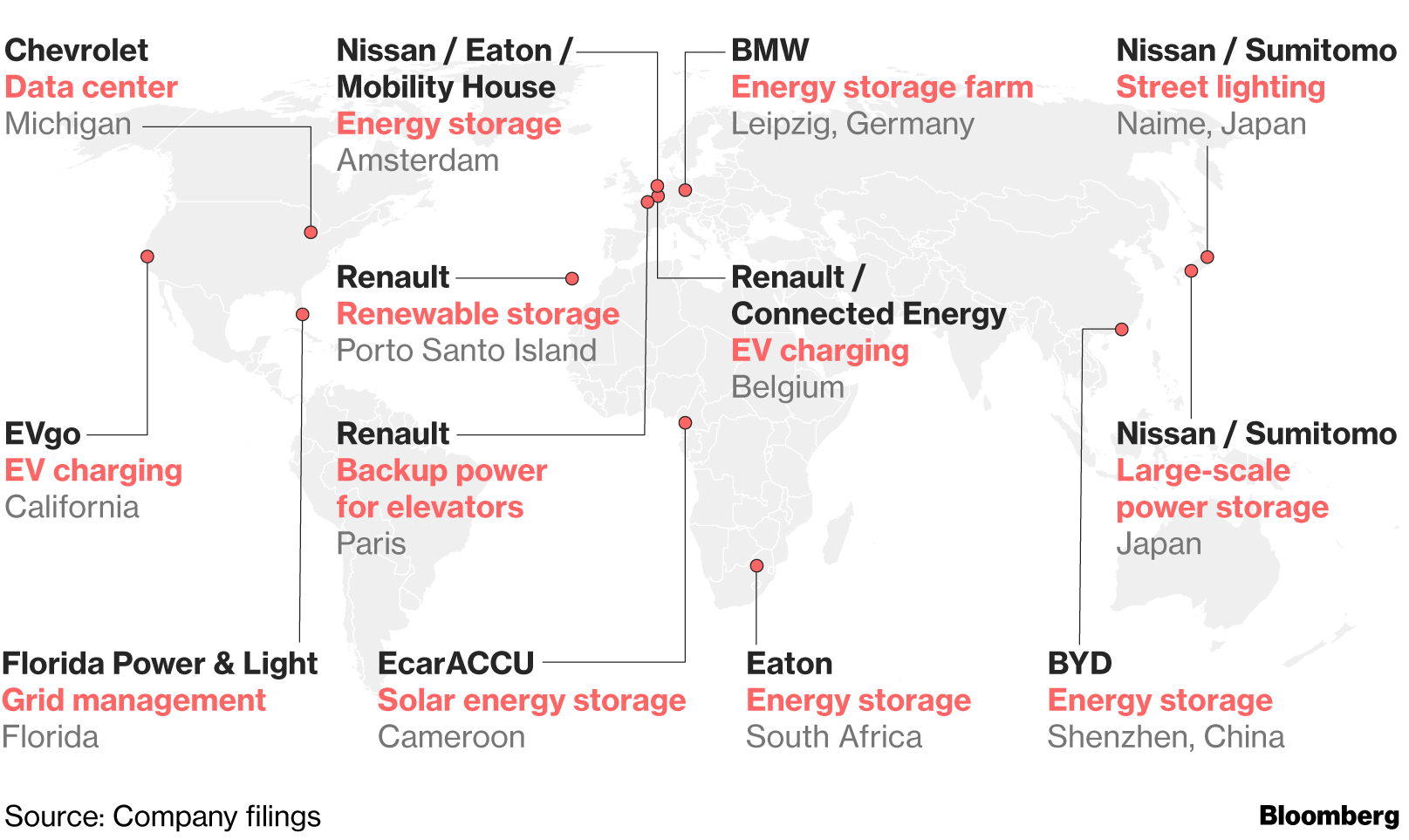Storage: Retirement home for old EV batteries?
The global shift from petroleum-fuelled to electric vehicles (EVs) has flagged an “urgency” in finding ways to reuse or recycle retired EV batteries[i].
BloombergNEF (BNEF) data shows that globally, the number of retired EV batteries is forecast to exceed 3.4 million packs by 2025, compared to around 55,000 in 2018. In August last year, China - where around half of all the world’s EVs are now sold - implemented a new rule to make carmakers liable for expired batteries amid increasing waste in the sector[ii]. While European car manufacturers are also responsible for ensuring that the batteries they install are properly disposed of at the end of their EV performance-life.
However new research shines a light on an emerging market for batteries that no longer meet EV performance standards – as remanufactured stationary storage for homes - offering a source of cheap and available battery storage. And it has car manufacturers sensing a business opportunity with some leading carmakers developing strategic alliances to create a second life market for used EV batteries.
A second life for EV batteries
EV performance standards typically require maintaining 80 per cent of total usable capacity and a resting self-discharge rate of around 5 per cent over a 24-hour period[iii]. A recent report by McKinsey & Company shows that after remanufacturing, batteries that have come to the end of their EV-life could still be useful in performing less-demanding applications than transportation, like stationary energy-storage services.
Shown in figure 1, due to the rapid rise of EVs, McKinsey estimate that repurposing EV batteries has the potential to exceed 200 gigawatt-hours by 2030, representing a global value upward of $30 billion by 2030.
Figure 1: Second-life EV batteries supply
 Source: McKinsey and Company
Source: McKinsey and Company
However, the report highlights a number of current challenges of reuse, such as:
- The array of battery packs that are specially designed for EV models, which increases refurbishing complexity;
- The estimated declining costs of new batteries which would reduce the cost disparity between used and new batteries;
- The lack of guarantees that exist regarding second-life-battery quality or performance; and,
- An immature regulatory regime.
Australia’s CSIRO echoes these challenges by also highlighting the lack of policy, protocols or certification around the reuse of batteries for energy storage. Stating that currently, consumers cannot be assured that second life batteries will provide a standard and reliable life span.
Yet McKinsey and the CSIRO remain optimistic. The CSIRO states that, generally, the best use of resources from a material and energy efficiency perspective is to reuse, before recycle. And irrespective of concerns, the increasing opportunity to reuse batteries by car manufacturers will continue to support the second-life opportunity.
While McKinsey believe these challenges can be overcome through targeted action. It suggests that automakers can design EVs with second-life applications in mind, and companies can industrialise and scale remanufacturing processes to reduce costs and maintain the value gap between new and used batteries. It also states that global agencies and private-sector coalitions are already working on industry-wide second-life battery safety standards.
Trialling second-life potential
Shown in figure 2, with global EV sales expected to rise (estimated 559 million vehicles to be electric by 2040[iv]) car manufacturers are jumping on board to pilot the potential of the emerging market of refurbished EV batteries.
Figure 2: Where electric batteries are being used and tested in new roles

In Europe, EV manufacturers have been ramping up production as tougher rules on reducing carbon emissions have come into force across the EU. There have been calls for a pan-European consortium to develop new battery technologies to build the domestic market and it was recently announced that European governments and companies - including Europe's biggest carmakers - are to form an alliance for developing next-generation batteries for EVs, investing five to six billion euros in the project.
Seeing new market opportunities, German car manufacturer Daimler has joined its subsidiary, Mercedes-Benz Energy, to launch projects using EV battery packs for stationary energy storage. Along with GETEC ENERGIE AG and technology company The Mobility House AG, Daimler has turned a retired coal-fired plant in Elverlingsen, Germany, into an energy storage facility using almost 2,000 modules from EV battery packs. It has connected three energy storage plants made of EV battery systems to the grid in Germany. The Elverlingsen project has 8.96 MW of installed capacity (9.8 MWh of energy capacity), with 1,920 battery modules installed at the former 330-MW coal plant[v].
BMW is aiming for a fully sustainable supply-chain, last year announcing that it was collaborating with Northvolt, Europe's largest battery factory for EVs, while also working with Umicore, a materials processing company, to develop battery reuse and recycling systems. In partnership with Bosch, BMW has also teamed with Swedish energy company Vattenfall, on a 2.8 MWh energy storage facility (a total power capacity of 2 MW) using batteries from BMW-model EVs. Located in Hamburg, 2,600 retired battery modules from more than 100 EVs are connected together to form a large power storage, which is used to stabilise the grid and reduce the impact of peak demand[vi].
Hyundai Motor Group and Finnish energy technology group Wärtsilä, have collaborated to use EV batteries in energy storage, which includes advanced energy storage technologies and software[vii]. While Chevy Volt batteries could also find new life through a General Motors pilot program, which has seen the carmaker team-up with American residential energy provider Duke Energy. Duke will trial lithium-ion batteries in grid test demonstrations to investigate the cost efficiencies and utility of the system, and to determine if the batteries can use in wider applications such as powering homes during black and brownouts. GM engineers say the Chevy Volt batteries could still supply an additional 15 years of energy after the cells reach the end of its vehicle performance-life[viii].
Nissan has collaborated with Eaton Industries, a worldwide energy management company, to develop xStorage Home in the UK, which offers solar panels for home with solar battery storage systems. Customers have a choice of buying a new battery or one that has lived its first life in a Nissan LEAF - the world’s first and one of the bestselling mass-market EVs. Nissan has also repurposed retired EV batteries into a power source for camping trailers: the Nissan x OPUS concept camper powers “off-grid adventures” with a storage capacity of 700Wh and a power output of 1kW, the lithium-ion cells are reclaimed from first-generation Nissan EVs[ix].
Due to a growing demand for electric cars in Japan, last year the country opened its first plant specialising in the reuse and recycling of lithium-ion batteries. Operated by 4R Energy Corporation, the plant is a joint venture between Nissan and Sumitomo Corporation. The batteries recycled and refabricated at the factory will be used to offer the world’s first exchangeable refabricated battery for EVs and will also be used in large-scale storage systems and electric forklifts.
Also in Japan, Toyota are planning to install their retired EV batteries outside 7-Eleven stores. The hybrid batteries will store power from solar panels to help power the stores.
Australia
More locally, the adoption of EVs in Australia has been low to date (accounting for around 0.15 per cent of new car sales[x]) with most of the focus on recycling EV batteries. But this rate is expected to rise. Currently, the majority of EV batteries are exported from Australia for end-of-life processing[xi]. However some companies provide incentives to swap batteries once their end of performance life is reached, like Toyota, who offers a rebate on new batteries when old ones are returned to manufacturer.
Yet there are still developments underway. Australian company Relectrify is currently a leading proponent of reuse for EV batteries. The Melbourne based start-up’s technology optimises second life battery operation for EV to energy storage solutions. Late last year, Relectrify announced a collaboration with 4R Energy Corporation to develop second-life battery storage solutions.
“Used electric vehicle batteries offer a significant opportunity to create compelling energy storage systems in Japan and beyond. Relectrify’s technology holds the key to achieving capable, long-lived storage in a cost-effective manner,” Eiji Makino, President of 4R Energy said.
Using Relectrify’s battery and inverter control technology 4R Energy will investigate further opportunities in the storage market, including the repurposing of used batteries from the Nissan LEAF.
[i] https://www.bloomberg.com/news/features/2018-06-27/where-3-million-electric-vehicle-batteries-will-go-when-they-retire
[ii] https://www.bloomberg.com/news/features/2018-06-27/where-3-million-electric-vehicle-batteries-will-go-when-they-retire
[iii] https://www.bloomberg.com/news/features/2018-06-27/where-3-million-electric-vehicle-batteries-will-go-when-they-retire
[iv] https://www.bloomberg.com/news/features/2018-06-27/where-3-million-electric-vehicle-batteries-will-go-when-they-retire
[v] https://www.powermag.com/ev-batteries-repurposed-for-energy-storage/
[vi] https://electrek.co/2016/09/22/bmw-bosch-energy-storage-facility-built-from-batteries-from-over-100-electric-cars/
[vii] https://www.powermag.com/ev-batteries-repurposed-for-energy-storage/
[viii] https://www.designnews.com/alternative-energy/old-ev-batteries-may-power-homes-one-day/163960373647882
[ix] https://www.nissan.com.au/discover/news/2019/feb/19/nissan-x-opus-concept-camper-uses-second-life-ev-batteries-to-power-off-grid-adventures
[x] https://www.csiro.au/en/Research/EF/Areas/Energy-storage/Battery-recycling
[xi] https://www.csiro.au/en/Research/EF/Areas/Energy-storage/Battery-recycling
Related Analysis
Certificate schemes – good for governments, but what about customers?
Retailer certificate schemes have been growing in popularity in recent years as a policy mechanism to help deliver the energy transition. The report puts forward some recommendations on how to improve the efficiency of these schemes. It also includes a deeper dive into the Victorian Energy Upgrades program and South Australian Retailer Energy Productivity Scheme.
Beyond the Rebate: Battery Policy, VPPs, and Household Returns
A re-elected Labor Government’s promise to cut home battery costs by 30 per cent through the Small-scale Renewable Energy Scheme (SRES) has sparked interest—and raised questions. While the move may accelerate battery uptake among solar households, critics warn it could deepen inequities by leaving renters and vulnerable customers behind. More importantly greater value will be realised if the storage capacity is also coordinated through mechanisms like Virtual Power Plants (VPPs). We take a look at the benefits of VPPs.
The return of Trump: What does it mean for Australia’s 2035 target?
Donald Trump’s decisive election win has given him a mandate to enact sweeping policy changes, including in the energy sector, potentially altering the US’s energy landscape. His proposals, which include halting offshore wind projects, withdrawing the US from the Paris Climate Agreement and dismantling the Inflation Reduction Act (IRA), could have a knock-on effect across the globe, as countries try to navigate a path towards net zero. So, what are his policies, and what do they mean for Australia’s own emission reduction targets? We take a look.
Send an email with your question or comment, and include your name and a short message and we'll get back to you shortly.



